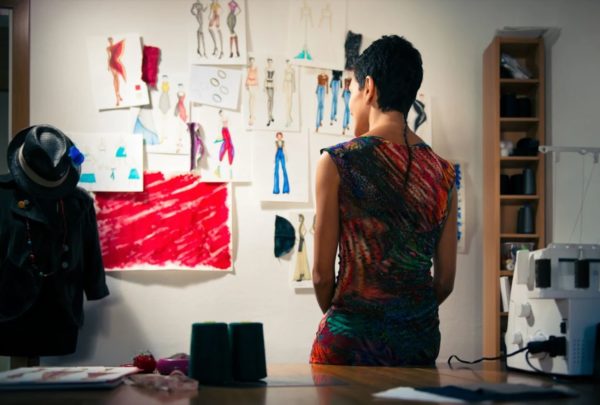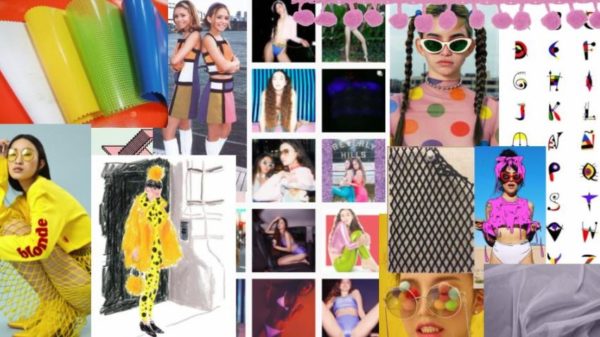
A mood board is a tool to help hash out all your research ideas and to put a solid direction to guide you through product development all the way through sales. It will help keep you on track with the overall feeling that inspired your fashion line while helping to communicate those “hard to put into words” details to others working with you!
Does this sound appealing so far? Well, rather than leave you hanging with this great tool to evolve your fashion inspo and ideas, we’ve gathered 12 Pro Tips that you can use to get your creative juices flowing and your bright ideas out in the open by creating a mood board!
1. See who’s #slaying the moodboard game
They say the hardest step is the first one… and that’s true of mood board creation too! Whether you’re creating a mood board for professional or personal use, starting out can be daunting, especially if you have never done it before. Ask creatives around you if they can show you their mood boards to get you on the right track, or scour examples on the internet like this page on TinkerLab – you can simply Google “moodboards” to find thousands of examples to get you started!
2. “Image Dump”

It’s not as gross as it sounds, I promise. An image dump is simply a giant spree of pinning, saving, and capturing images into one lace for use later. The great thing about an image dump is that you don’t have to concentrate on specific aesthetics or themes just yet – just spend some time collecting images that inspire you. I like Pinterest for my image dumping – as an intelligent platform, it’s like a rabbit hole, always recommending images for me based on previous pins!
3. Get out there
You don’t have to be at your desk to collect ideas for your mood board – there’s a whole world out there beyond your computer screen! Grab your camera when you head to museums, galleries, especially while shopping the market. You can take pics of garment features such as construction details, seams, and trims – all of which will also help with adding value to your garment tech pack. See any products that are innovative or niche as well? Snap photos of anything that captures your interest, you never know what you’ll find!
4. Always be “on”
The world moves quickly – if you see a photo you like, save it for later. Follow Instagram accounts that you find aesthetically pleasing and use the save feature whenever something pops up. Scroll through Tumblr or Pinterest before you go to sleep and save anything that inspires you, or that you find innovative or unique. If you see someone wearing something cool, ask if you can take a pic. You can also take scan photos in magazines that capture your attention, or simply tear out the page!
5. Experiment with platforms

While I generally like to go digital, a mood board can also be created using a physical platform, like a poster, a bulletin board, or a wall. Regardless of platform, the best mood boards use both physical items and sketches, so if you’re working on a computer, you can photograph physical items such as fabrics, trims, and other garment details. Don’t forget to take photographs of your own fashion illustrations! The benefit of working digitally means you can email the board easily as needed, but taking a photo of your physical mood board also works!
6. Don’t limit yourself to fashion!
It may seem logical to use images of clothing, patterns, and fabric swatches in your mood boards, but that doesn’t mean you can’t use other inspirational photos! Remember – this isn’t the final product, it’s a collection of ideas used to represent the vibe of your venture. I like to use typography, illustrations, makeup designs, quotes, architecture, food, and even photos of random objects such as telephones or public figures that fit the theme to convey the overall feeling. This will help with sales and merchandising – for example, if your mood board reflects that the line was inspired by your travels, a catalog display can reflect this theme as well when promoting your product!
7. Give it a name

Give your mood board a creative name, one that summarizes your mood board in one or two words maximum. Not only will it succinctly describe your mood board’s vibe, but it’s also nice to reference once you’ve built a portfolio of many mood boards, and are using them to pitch… For example, I named this mood board “Linear” because the crisp patterns, bagginess, illustrative outlines, and overall angsty-sulky way it made me feel seemed to fit with the name. I can just use this name (instead of a looooooong, unnecessary description) when referring to a specific mood board for simplicity when dealing with investors or other contributors to the project – nice and easy!
8. Colour Tip
Colour evokes mood and emotion, and really tells you what the tone of a fashion piece is. You can give yourself a headstart on how your line will affect a room’s atmosphere by colour forecasting using the Pantone Reference Book (click here see our exciting blog post about why every fashion professional needs one of these!). Add in the colour reference number and try to limit colour variations in a style to 1 or 2 – this will make your design and production process later much easier!
9. Start with Why
Beyond personal or financial fulfillment, you must have a reason behind the creation of a fashion line in order to succeed in the business. Is your product solving a problem? Can you visually illustrate how your product is solving this problem? Do you have a niche market? Can you bring something to that table that is so unique, it can’t be easily duplicated and mass-produced by competitors?What sets you apart of the rest? No matter where you are in the process of creating a mood board, you must be able to answer the one-word question of: “why?”
10. One size does not fit all
This isn’t a one-and-done type of deal – you can have as many mood boards as your heart desires… in fact, the more the better! Some fashion designers choose to make a mood board for each individual design piece to work through product development, while others choose to put all of their season’s styles onto one mood board. There is no “wrong” way of doing this – choose whichever best suits your tastes and needs, and let your creativity flow!
11. Make Every Detail Count
Make sure there is a reason behind every image, a portion of text, or fabric swatch. Don’t add it in simply because you like it – that’s what image dumping is for! If you can fine tune and add details such as the trims or embellishments, even better! Actually curating your mood board is for fine-tuning the idea and picking which elements represent it best. You should be able to fully describe why you’ve included each and every portion in the particular mood board.
And finally… perhaps the most important one….
12. The Time Is Now
Don’t wait for inspiration to hit… go out and find it! I myself sometimes have ideas that float through my head, and I think, “it’s too random, too incomplete to do anything with; I’ll wait until it’s a bit more developed.” No!!!! This is exactly what a mood board is for – if you already had the end result, you wouldn’t need a mood board. Creating a mood board helps to propel the idea and begin it get it into a tangible form, even if you don’t know what the end product or design will be. No matter what stage your project is in, it will benefit from creating a mood board!
What sorts of unique elements have you used in your mood boards? Do you have any inspiring stories or experiences with creating or pitching using a mood board? We’d love to hear!
P.S. Like what you see here? There’s more of this juicy information in the Source My Garment book- An insiders guide to responsibly manufacturing offshore. Pre-order your copy soon – here!


